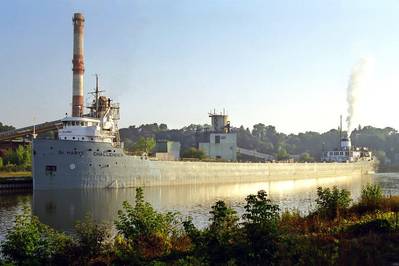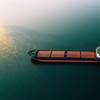First U.S.-Flag "Lakers" Back In Service; 52 More To Follow
The 2013 Great Lakes shipping season began on March 2 with the sailing of the tug/barge unit Prentiss Brown/St. Mary’s Conquest. The vessel, operated by Port City Marine Services, departed its winter lay-up berth in Milwaukee and sailed for Charlevoix, Michigan, where it loaded 9,200 tons of cement for delivery to Chicago.
Next to get underway was the tug/barge unit Dorothy Ann/Pathfinder. The vessel, one of 10 operated by The Interlake Steamship Company, loaded about 13,000 tons of iron ore at Cleveland Bulk Terminal in Cleveland, Ohio, on March 4 for delivery to the steel mill at the end of the deep-draft section of the Cuyahoga River.
Over the next several weeks, 52 more U.S.-flag lakers will return to service and spend 10-plus months hauling the raw materials that are the foundation of the industrial heartland, primarily iron ore, limestone and coal. During the course of the season more than 1,600 American mariners will crew these vessels.
The U.S.-flag Great Lakes fleet is unique in the world in that virtually every vessel is a self-unloader, which means the ship or barge can discharge cargo without any assistance from shoreside personnel or equipment. The largest vessels can unload 70,000 tons of cargo in 12 hours or less. Prior to self-unloading, it would have taken days to empty a vessel of a cargo that size.
The self-unloading vessel was invented and perfected on the Great Lakes and is one reason waterborne commerce on the Inland Seas is so efficient. A recent study by the U.S. Maritime Administration states that “on average, transportation cost savings from $10 to more than $20 per ton are associated with the use of lakers compared to the next most competitive transportation mode.” The U.S. Army Corps of Engineers estimates that Great Lakes shipping annually saves its customers $3.6 billion compared to the next least costly mode of transportation.
By law - the Jones Act - U.S.-flag lakers are built in the United States, crewed by American citizens and owned by American corporations. This holds the vessels to the world’s highest safety and operational standards and mandates that crews pass demanding U.S. Coast Guard exams.
The environment benefits when the Lakes fleet returns to service. Vessels use less fuel to move a ton of cargo than trains or trucks and produce significantly fewer emissions in the process. A number of lakers have been repowered in recent years with state-of-the-art engines and generators that have further reduced the industry’s carbon footprint.
Iron ore for steel production is the primary cargo moved by U.S.-flag lakers. In 2012, the fleet moved more than 45 million tons of taconite pellets. Limestone for the construction industry and steelmaking approached 22 million tons. Coal for power generation totaled more than 17 million tons. Other cargos included cement, salt, sand and grain and collectively totaled 5 million tons.
Those totals were impacted by the dredging crisis on the Great Lakes. At the end of 2012, the largest vessels were leaving more than 10,000 tons of cargo behind because of inadequate dredging and falling water levels. If the full length of the Federal navigation channel in the Cuyahoga River was dredged to its project depth, 23 feet, the Pathfinder would have been able to carry 3,200 more tons. The vessel is scheduled to shuttle ore within Cleveland Harbor for four weeks, so will forfeit approximately 77,000 tons.
There is no reason the Great Lakes Navigation System cannot be maintained to project depth. The cargos that move on the Lakes (and East, Gulf and West Coasts) are taxed and the receipts are deposited in the Harbor Maintenance Trust Fund (“HMTF”). Nationwide the tax generates about $1.6 billion per year, but the HMTF typically only spends about $750 million. The surplus, about $7 billion, is used to mask the size of the Federal deficit. As a result, more than 18 million cubic yards of sediment now clog Great Lakes ports and waterways.
Legislation that would require the HMTF to spend what it takes in for dredging on dredging has been introduced in both the House and Senate. H.R. 335 was introduced on January 22 and already has 94 co-sponsors, 17 from Great Lakes districts. S. 218 was introduced on February 4, and has 31 co-sponsors, including 12 of the 16 Great Lakes Senators. The U.S. Army Corps of Engineers estimates it would cost about $200 million to restore the Great Lakes Navigation System, just a fraction of the surplus amassed in the HMTF.
The next vessels to enter service will be two cement carriers on March 7. The iron ore trade out of Escanaba, Michigan, is expected to resume on March 14.
Lake Carriers’ Association represents 17 American companies that operate 57 U.S.-flag vessels on the Great Lakes and carry the raw materials that drive the nation’s economy: iron ore and fluxstone for the steel industry, limestone and cement for the construction industry, coal for power generation, as well as salt, sand and grain. Collectively, these vessels can transport more than 115 million tons of cargo per year. Those cargos generate and sustain more than 103,000 jobs in the United States and have an economic impact of more than $20 billion.
www.lcaships.com











